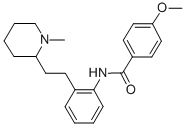Description
Encainide is a membrane-active class I c
agent with complex metabolism and clinical
pharmacology , . To date, its effectiveness
has been proved against ventricular arrhythmias.
Uses
Cardiac depressant (anti-arrhythmic.
Definition
ChEBI: Encainide is 4-Methoxy-N-phenylbenzamide in which the hydrogen at the 2 position of the phenyl group is substituted by a 2-(1-methylpiperidin-2-yl)ethyl group. A class Ic antiarrhythmic, the hydrochloride was used for the treatment of severe or life-threatening ventricular arrhythmias, but it was associated with increased death rates in patients who had asymptomatic heart rhythm abnormalities after a recent heart attack and was withdrawn from the market. It has a role as an anti-arrhythmia drug and a sodium channel blocker. It is a member of piperidines and a member of benzamides.
Brand name
Enkaid
(Bristol Labs).
World Health Organization (WHO)
The membrane-stabilizing antiarrhythmic agent encainide was
introduced into medicine in the mid-1980's. The decision to delete the indications
for patients with asymptomatic and less severe symptomatic ventricular
arrhythmias was taken on the basis of the results of a trial (CAST study) that
showed a two-fold increase in deaths in post-myocardiac patients taking encainide
compared with the placebo group. (See also WHO comment for flecainide).
Side effects
Side effects include central nervous system
activity.
Synthesis
Encainide, 4-methoxy-N-[2-[2-(1-methyl-2-piperidinyl)ethyl]phenyl]-benzamide
(18.1.15), is synthesized by acylating 2-(1-methyl-2-piperidylethyl)aniline with 4-
methoxybenzoic acid chloride. The chemical structure of encainide is substantially
different than other local anesthetics and antiarrhythmics.


